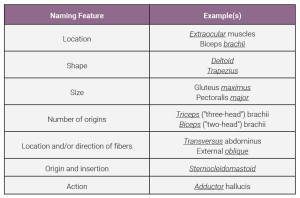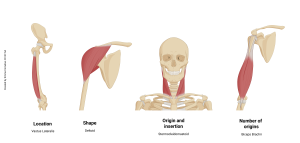Muscle Naming
Objective 10.9
10.9.1 Relate the different terms used to name muscles.
It is often easier to learn the names of the muscles if you understand why they are named the way they are. A number of different schemes exist for naming muscles. Identifying the name of each muscle is much easier if you can break down what the names mean.
Names can be based on several features: location, size, shape, number of origins, location and/or direction of fibers, origin and insertion, or action.
This table will indicate the naming qualities and provide an example or each.

You may have noticed that a lot of muscles combine naming features such as location and size for pectoralis major. Another example is number of origins and location with triceps brachii. As you learn the muscles in the next few objectives, you should look for the naming features introduced in this objective.

Before we start learning the major muscles of the body, you should understand that we are not learning all of the muscles in the body or many of their specific origins, insertions, or actions. We have abbreviated their complexity for improved understanding. At times, muscles will be grouped and you will not need to learn their individual names. The details that you need to know about these muscles are outlined in each muscle table.
In anatomy we often have several terms that describe the same thing. You will find this is the case as you study muscle anatomy and function. Here are some terms that we will use may be used interchangeable in various textbooks, on the internet, or elsewhere.
- Origin = proximal attachment
- Insertion = distal attachment
- Internal rotation = medial rotation
- External rotation = lateral rotation
- Elbow flexion = forearm flexion (adapted for several joints and movements)
Media Attributions
- U10-036 muscle naming table © Bizzell, Lizz is licensed under a CC BY-SA (Attribution ShareAlike) license
- U10-037 muscle naming conventions © Cornelius, Emma is licensed under a CC BY-SA (Attribution ShareAlike) license

